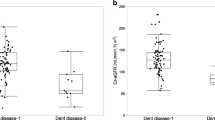Abstract
Objective
To describe the clinical and genotypic features of Dent disease in children diagnosed at our center over a period of 10 years.
Design
Case series.
Setting
Pediatric Nephrology Clinic at a referral center in Northern India.
Methods
The medical records of patients with Dent disease diagnosed and followed up at this hospital from June 2005 to April 2015 were reviewed. The diagnosis of Dent disease was based on presence of all three of the following: (i) low molecular weight proteinuria, (ii) hypercalciuria and (iii) one of the following: nephrolithiasis, hematuria, hypophosphatemia or renal insufficiency, with or without mutation in CLCN5 or OCRL1 genes.
Results
The phenotype in 18 patients diagnosed with Dent disease during this period was characterized by early age at onset (median 1.8 y), and polyuria, polydipsia, salt craving, hypophosphatemic rickets and night blindness. Rickets was associated with severe deformities, fractures or loss of ambulation in six patients. Nephrocalcinosis was present in three patients, while none had nephrolithiasis. Generalized aminoaciduria was seen in 13 patients, two had glucosuria alone, and one had features of Fanconi syndrome. Over a median follow up of 2.7 years, one patient developed renal failure. Genetic testing (n=15) revealed 5 missense mutations and 3 nonsense mutations in CLCN5 in 13 patients. Five of these variations (p.Met504Lys, p.Trp58Cys, p.Leu729X, p.Glu527Gln and p.Gly57Arg) have not been reported outside the Indian subcontinent.
Conclusion
Our findings suggest a severe phenotype in a cohort of Indian patients with Dent disease.
Similar content being viewed by others
References
Dent CE, Friedman M. Hypercalciuric rickets associated with renal tubular damage. Arch Dis Child. 1964;39:240–9.
Wrong OM, Norden AG, Feest TG. Dent’s disease: a familial proximal renal tubular syndrome with lowmolecular weight proteinuria, hypercalciuria, nephrocalcinosis, metabolic bone disease, progressive renal failure and a marked male predominance. QJM. 1994;87:473–93.
Scheinman SJ. X-linked hypercalciuric nephrolithiasis: clinical syndromes and chloride channel mutations. Kidney Int. 1998;53:3–17.
Pook MA, Wrong O, Wooding C, Norden AG, Feest TG, Thakker RV. Dent’s disease, a renal Fanconi syndrome with nephrocalcinosis and kidney stones, is associated with a micro-deletion involving DXS255 and maps to Xp11.22. Hum Mol Genet. 1993;2:2129–34.
Hoopes RR, Raja KM, Koich A, Hueber P, Reid R, Knohl SJ, et al. Evidence of genetic heterogeneity in Dent’s disease. Kidney Int. 2004;65:1615–20.
Hoopes RR, Shrimpton AE, Knohl SJ, Hueber P, Hoppe B, Matyus J, et al. Dent disease with mutations in OCRL1. Am J Hum Genet. 2005;76:260–7.
Shrimpton AE, Hoopes RR Jr, Knohl SJ, Hueber P, Reed AA, Christie PT, et al. OCRL1 mutations in Dent 2 patients suggest a mechanism for phenotypic variability. Nephron Physiol. 2009;112:27–36.
Ludwig M, Utsch B, Monnens LAH. Recent advances in understanding the clinical and genetic heterogeneity of Dent’s disease. Nephrol Dial Transplant. 2006;21:2708–17.
Sethi SK, Ludwig M, Kabra M, Hari P, Bagga A. Vitamin A responsive night blindness in Dent’s disease. Pediatr Nephrol. 2009;24:1765–70.
Hari P, Biswas B, Pandey R, Kalaivani M, Kumar R, Bagga A. Updated height and creatinine based equation and its validation for estimation of glomerular filtration rate in children from developing countries. Clin Exp Nephrol. 2012;16:697–705.
Ludwig M, Doroszewicz J, Seyberth HW, Bökenkamp A, Balluch B, Nuutinen M, et al. Functional evaluation of Dent’s disease-causing mutations: implications for ClC-5 channel trafficking and internalization. Hum Genet. 2005;117:228–37.
Lloyd SE, Gunther W, Pearce SHS, Thomson A, Bianchi ML, Bosio M, et al. Characterization of renal chloride channel, CNCN5, mutations in hypercalciuric nephrolithiasis (kidney stones) disorders. Human Mol Genet. 1997;6:1233–9.
Takemura T, Hino S, Ikeda M, Okada M, Igarashi T, Inatomi J, et al. Identification of two novel mutations in the CLCN5 gene in Japanese patients with familial idiopathic low molecular weight proteinuria (Japanese Dent’s disease). Am J Kidney Dis. 2001;37:138–43.
Wu F, Roche P, Christie PT, Loh NY, Reed AAC, Esunof RM, et al. Modeling study of human renal chloride channel (hCLC-5) mutations suggests a structural functional relationship. Kidney Int. 2003;63:1426–32.
Dutzler R, Campbell EB, Cadene M, Chait BT, Mac Kinnon R. X-ray structure of a ClC chloride channel at 3.0Å reveals the molecular basis of anion selectivity. Nature. 2002;415:287–94.
Mansour-Hendili L, Blanchard A, Pottier NL, Roncelin I, Lourdel S, Treard C, et al. Mutation update of the CLCN5 gene responsible for Dent disease 1. Hum Mutat. 2015;36:743–52.
Sekine T, Komoda F, Miura K, Takita J, Shimadzu M, Matsuyama T, et al. Japanese Dent disease has a wider clinical spectrum than Dent disease in Europe/USA: genetic and clinical studies of 86 unrelated patients with low-molecular-weight proteinuria. Nephrol Dial Transplant. 2014;29:376–84.
Anglani F, D’Angelo A, Bertizzolo LM, Tosetto E, Ceol M, Cremasco D, et al., on behalf of Dent disease Italian network. Nephrolithiasis, kidney failure and bone disorders in Dent disease patients with and without CLCN5 mutations. Springer Plus. 2015;4:492–8.
Annigeri RA, Rajagopalan R. Hypophosphatemic rickets due to Dent’s disease: A case report and review of literature. Indian J Nephrol. 2009;19:163–6.
Bolino A, Devoto M, Enia G, Zoccali C, Weissenbach J, Romeo G. Genetic mapping in the Xp11.2 region of a new form of X-linked hypophosphatemic rickets. Eur J Hum Genet. 1993;14:269–9.
Kelleher CL, Buckalew VM, Frederickson ED, Rhodes DJ, Conner DA, Seidman JG, et al. CLCN5 mutation Ser244Leu is associated with X-linked renal failure without X-linked recessive hypophosphatemic rickets. Kidney Int. 1998;53:31–7.
Bockenhauer D, Bichet DG. Inherited secondary nephrogenic diabetes insipidus: concentrating on humans. Am J Physiol Renal Physiol 2013;304:F1037–42.
Bustamante M, Hasler U, Leroy V, De Seigneux S, Dimitrov M, Mordasini D, et al. Calcium-sensing receptor attenuates AVP-induced aquaporin-2 expression via a calmodulin-dependent mechanism. J Am Soc Nephrol. 2008;19:109–16.
Devuyst O, Thakker RV. Dent disease. Orphanet J Rare Dis. 2000;5:28–35.
Becker-Cohen R, Rinat C, Ben-Shalom E, Feinstein S, Ivgi H, Frishberg Y. Vitamin A deficiency associated with urinary retinol binding protein wasting in Dent’s disease. Pediatr Nephrol. 2012;27:1097–102.
Author information
Authors and Affiliations
Corresponding author
Rights and permissions
About this article
Cite this article
Bhardwaj, S., Thergaonkar, R., Sinha, A. et al. Phenotype of dent disease in a cohort of Indian children. Indian Pediatr 53, 977–982 (2016). https://doi.org/10.1007/s13312-016-0971-4
Received:
Revised:
Accepted:
Published:
Issue Date:
DOI: https://doi.org/10.1007/s13312-016-0971-4



